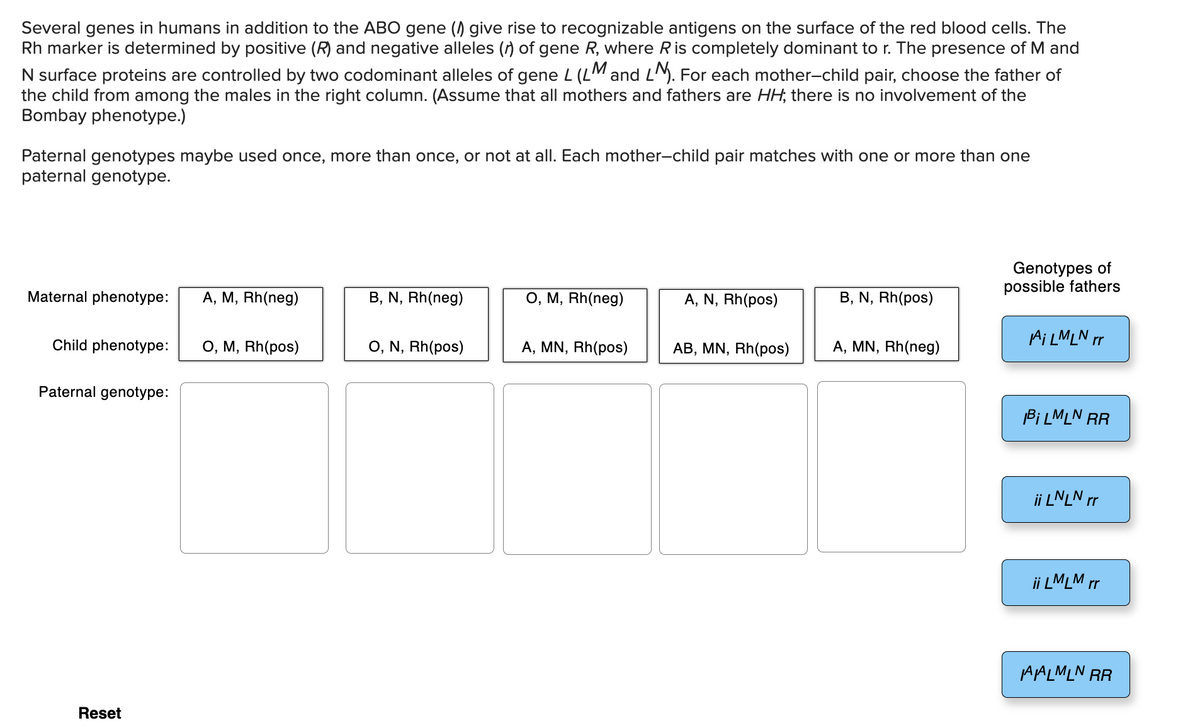aternal genotype. Maternal phenotype: Child phenotype: Paternal genotype: Reset A, M, Rh(neg) O, M, Rh(pos) B, N, Rh(neg) O, N, Rh(pos) O, M, Rh(neg) A, MN, Rh(pos) A, N, Rh(pos) AB, MN, Rh(pos) B, N, Rh(pos) A, MN, Rh(neg) Genotypes of possible fathers AiLMLN rr BİLMLN RR ii LNLN rr ii LMLM rr AALMLN RR
aternal genotype. Maternal phenotype: Child phenotype: Paternal genotype: Reset A, M, Rh(neg) O, M, Rh(pos) B, N, Rh(neg) O, N, Rh(pos) O, M, Rh(neg) A, MN, Rh(pos) A, N, Rh(pos) AB, MN, Rh(pos) B, N, Rh(pos) A, MN, Rh(neg) Genotypes of possible fathers AiLMLN rr BİLMLN RR ii LNLN rr ii LMLM rr AALMLN RR
Concepts of Biology
1st Edition
ISBN:9781938168116
Author:Samantha Fowler, Rebecca Roush, James Wise
Publisher:Samantha Fowler, Rebecca Roush, James Wise
Chapter8: Patterns Of Inheritance
Section: Chapter Questions
Problem 11RQ: The ABO blood groups in humans are expressed as the IA,IB and i alleles. The IAallele encodes the A...
Related questions
Topic Video
Question

Transcribed Image Text:Several genes in humans in addition to the ABO gene () give rise to recognizable antigens on the surface of the red blood cells. The
Rh marker is determined by positive (R) and negative alleles () of gene R, where R is completely dominant to r. The presence of M and
N surface proteins are controlled by two codominant alleles of gene L (LM and LM. For each mother-child pair, choose the father of
the child from among the males in the right column. (Assume that all mothers and fathers are HH; there is no involvement of the
Bombay phenotype.)
Paternal genotypes maybe used once, more than once, or not at all. Each mother-child pair matches with one or more than one
paternal genotype.
Maternal phenotype:
Child phenotype:
Paternal genotype:
Reset
A, M, Rh(neg)
O, M, Rh(pos)
B, N, Rh(neg)
O, N, Rh(pos)
O, M, Rh(neg)
A, MN, Rh(pos)
A, N, Rh(pos)
AB, MN, Rh(pos)
B, N, Rh(pos)
A, MN, Rh(neg)
Genotypes of
possible fathers
AiLMLN rr
BiLMLN RR
ii LNLN rr
ii LMLM rr
AALMLN RR
Expert Solution
This question has been solved!
Explore an expertly crafted, step-by-step solution for a thorough understanding of key concepts.
Step by step
Solved in 4 steps with 4 images

Knowledge Booster
Learn more about
Need a deep-dive on the concept behind this application? Look no further. Learn more about this topic, biology and related others by exploring similar questions and additional content below.Recommended textbooks for you

Concepts of Biology
Biology
ISBN:
9781938168116
Author:
Samantha Fowler, Rebecca Roush, James Wise
Publisher:
OpenStax College

Biology: The Unity and Diversity of Life (MindTap…
Biology
ISBN:
9781305073951
Author:
Cecie Starr, Ralph Taggart, Christine Evers, Lisa Starr
Publisher:
Cengage Learning

Human Heredity: Principles and Issues (MindTap Co…
Biology
ISBN:
9781305251052
Author:
Michael Cummings
Publisher:
Cengage Learning

Concepts of Biology
Biology
ISBN:
9781938168116
Author:
Samantha Fowler, Rebecca Roush, James Wise
Publisher:
OpenStax College

Biology: The Unity and Diversity of Life (MindTap…
Biology
ISBN:
9781305073951
Author:
Cecie Starr, Ralph Taggart, Christine Evers, Lisa Starr
Publisher:
Cengage Learning

Human Heredity: Principles and Issues (MindTap Co…
Biology
ISBN:
9781305251052
Author:
Michael Cummings
Publisher:
Cengage Learning